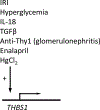The role of CD47 in pathogenesis and treatment of renal ischemia reperfusion injury
- PMID: 30392076
- PMCID: PMC6677644
- DOI: 10.1007/s00467-018-4123-z
The role of CD47 in pathogenesis and treatment of renal ischemia reperfusion injury
Abstract
Ischemia reperfusion (IR) injury is a process defined by the temporary loss of blood flow and tissue perfusion followed later by restoration of the same. Brief periods of IR can be tolerated with little permanent deficit, but sensitivity varies for different target cells and tissues. Ischemia reperfusion injuries have multiple causes including peripheral vascular disease and surgical interventions that disrupt soft tissue and organ perfusion as occurs in general and reconstructive surgery. Ischemia reperfusion injury is especially prominent in organ transplantation where substantial effort has been focused on protecting the transplanted organ from the consequences of IR. A number of factors mediate IR injury including the production of reactive oxygen species and inflammatory cell infiltration and activation. In the kidney, IR injury is a major cause of acute injury and secondary loss of renal function. Transplant-initiated renal IR is also a stimulus for innate and adaptive immune-mediated transplant dysfunction. The cell surface molecule CD47 negatively modulates cell and tissue responses to stress through limitation of specific homeostatic pathways and initiation of cell death pathways. Herein, a summary of the maladaptive activities of renal CD47 will be considered as well as the possible therapeutic benefit of interfering with CD47 to limit renal IR.
Keywords: CD47; Ischemia reperfusion injury; Kidney; Renal; SIRP-α; Thrombospondin-1.
Conflict of interest statement
Figures


References
-
- Powell RW, Dyess DL, Collins JN, Roberts WS, Tacchi EJ, Swafford AN Jr., Ferrara JJ, Ardell JL (1999) Regional blood flow response to hypothermia in premature, newborn, and neonatal piglets. J Pediatr Surg 34:193–198. - PubMed
-
- Ataka K, Chen D, Levitsky S, Jimenez E, Feinberg H (1992) Effect of aging on intracellular Ca2+, pHi, and contractility during ischemia and reperfusion. Circulation 86:II371–376. - PubMed
-
- Simkhovich BZ, Marjoram P, Poizat C, Kedes L, Kloner RA (2003) Age-related changes of cardiac gene expression following myocardial ischemia/reperfusion. Arch Biochem Biophys 420:268–278. - PubMed
Publication types
MeSH terms
Substances
Grants and funding
LinkOut - more resources
Full Text Sources
Research Materials

